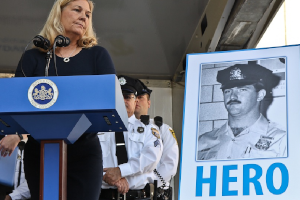Myth # 12
Myths About Mumia
Jamal’s supporters argue that the ballistics testing was “mistake” filled. His lawyers contend that a Trace Metal Detection test should have been done on Officer Faulkner’s jacket to determine what distance the bullet that struck him in the back was fired from — suggesting that if the results had shown that Faulkner had been shot from a substantial distance, it would support their contention that a third person, other than Jamal had fired the shot and run from the scene. They say that a Neutron Activation Test should have been done on Jamal’s hands to determine if he had recently fired a weapon. They also assert that the police should have “sniffed” the barrel of Mr. Jamal’s gun to determine if it had been fired that morning.
In their docudrama “A Case for Reasonable Doubt”, HBO-TV presents Dr. Herbert McDonald, a hired “ballistics expert,” who claims that these supposed failures fell short of the acceptable standard of the day.
In the courtroom, Jamal’s lawyers have said that the prosecution and the police conspired to either limit the ballistics tests that were done in 1982 or to suppress the results of some of the tests because they didn’t produce the results needed to convict Jamal.
BRIEF REBUTTAL
HBO-TV was either lying or did absolutely no research when they claimed that “no Trace Metal Detection Test” was done in 1982 and that the prosecution’s ballistics expert found “no evidence of any gunpowder residue.” A Trace Metal Detection test was done. It confirmed that there was “primer lead” (gunpowder) residue on Officer Faulkner’s jacket, and that Officer Faulkner had been shot in the back from a range of no more than 24 inches — not, as Jamal’s lawyers claim, from many feet away by a mysterious running man. Similarly, primer lead residue was found on Jamal’s clothes, proving that the officer had shot him from a distance of less than two feet.
Jamal’s hands were not tested by neutron activation analysis, for good reason. When he struggled with police while they attempted to handcuff him, Jamal precluded such a test by rendering it invalid in advance. Heavy particle residue (gunpowder residue) that can be found by neutron activation is easily contaminated or lost by any kind of jostling, brushing, or energetic conduct by the shooter. Jamal’s fight against being arrested, which required the police to subdue him and carry him bodily to a police wagon after handcuffing him, rendered any such test invalid before it could be conducted. For that reason, none was done. In his 1995 PCRA testimony, Jamal’s own ballistics expert, George Fassnacht, agreed that a neutron activation test would have been “very difficult to perform” on Jamal’s hands, given his struggle with police. It was not a “mistake” not to test Jamal’s hands. There was no point in performing an invalid test.
(Further, there is no question that Jamal had been shot in the chest and had to be taken to the hospital. One can only imagine the accusations of “police abuse” had Jamal been kept at the scene to test his hands).
As for the so-called “sniff test” (sniffing the barrel of the gun to see if it smells as though it had recently been fired) called for by Jamal’s attorneys, Jamal’s own ballistics expert testified that this is not an accepted ballistics test. As explained in 1995 by George Fassnacht, Jamal’s ballistics expert, the so-called “smell test” has no scientific validity because it is completely subjective — “[there would be] no way to prove [a] sniffing officer right or wrong in the courtroom.” Fassnacht further admitted that the “sniff test” is simply one investigative technique that can be used by the police in the absence of eyewitnesses to help determine what might have happened at a crime scene. Here, multiple eyewitnesses saw Jamal fire his gun. There was no need to idiotically smell the barrel of Jamal’s gun to see if he had fired it. And even if the gun had been “sniffed,” the conclusion of the sniffing officer would have been attacked in the courtroom.
FACTS SUPPORTING OUR REBUTTAL
THE TRACE METAL DETECTION TEST
In their documentary, “A Case for Reasonable Doubt”, HBO goes to great lengths to argue that there were no ballistics tests done on Officer Faulkner’s jacket. They also claim that a Trace Metal Detection test should have been done to determine if there was evidence of nitrates on the jacket. To this day, Jamal’s uninformed supporters still make this argument despite the fact that it has repeatedly been exposed as a total fraud. In their docudrama, HBO-TV hired their own ballistics expert, Dr. Herbert MacDonald, who stated that had such a test been conducted on Officer Faulkner’s jacket, it would have verified that no nitrates or nitrites were present on the jacket.
McDonald claimed that this would verify that Faulkner was shot in the back from a distance greater than 24 inches. Opening the door for the possibility that someone who was more than two feet away from Faulkner shot him. Thus, supposedly, exonerating Jamal.
To support their position, HBO had Dr. McDonald run his own test. The TV drama shows McDonald putting the jacket on a square wooden frame and dramatically firing a gun into it from a distance of two feet. McDonald then triumphantly tests the jacket and, lo and behold, finds trace residue from the gunshot. McDonald then declares that had such a test been done in 1982, it could have produced a different result, proving that Officer Faulkner was shot from a distance greater than 2 feet, which would supposedly have supported the “running man” myth.
Well, McDonald was partly right. Had such a test been done, and had the shot been fired from less than two feet, it would have found gunshot residue. Unfortunately for the credibility of McDonald and HBO’s botched documentary, the test was done in 1982, and it proved that the shot was fired from close range, thus — once again — disproving the “running man” myth and once again exposing Jamal’s supporter’s willingness to lie to achieve their goal.
HOW DID HBO MISS THE 1982
BALLISTICS TESTS RESULTS?
The trial record, which HBO apparently just did not bother to read, unequivocally shows that a trace metals test confirmed the presence of primer lead on Officer Faulkner’s jacket, and established that he had been shot in the back from a distance of less than 24 inches. Only two people were seen by the five eyewitnesses to have come that close to Officer Faulkner — William Cook and Mumia Abu-Jamal.
Charles Tumosa, the prosecution’s crime scene investigation expert, testified as follows:
Tumosa: “Test for nitrates, combustion products of emission, were negative. Tests for lead indicated a presence of primer lead.”
N.T. 6/28/82, 15
ADA Joe McGill: “Now, you stated that the test for lead indicated the presence of primer lead. Would you tell me what you mean by that?”
Mr. Tumosa: “The second source of lead which may come about comes from the primer of the cartridge. When the firing pin of a weapon strikes this primer, the primer explodes, sets off the powder inside the cartridge. The cartridge then propels the projectile. The compound which sets off the explosion, is a lead compound. It is an organic lead compound, which is sensitive. So, at close distances, or a distance, the primer lead actually is blown through the barrel of a particular weapon much like — you can think of it in terms of a hose. If you hold a hose level, a projector of water will come out and hit the ground at a particular point. Well, the same thing will occur when the weapon is discharged. You have powder in the barrel. You have graphite’s. You have unburned ammunition. You also have this primer lead coming out much the same way water would come out of a hose held level and falls off at a particular distance.”
N.T. 6/26/82, 16-17
ADA McGill: “Did you make any kind of findings in relation to any comparison of the primer lead around that particular hole [in the jacket]?”
Mr. Tumosa: “We determined that the weapon must have been twelve inches or less when discharged.”
N.T. 6/26/82, 17
WHY DIDN’T THE TRACE METAL
TEST SHOW NITRATES?
Contradicting HBO, Jamal’s lawyer Leonard Weinglass has acknowledged that a trace metal test was done in 1982, but complains that it failed to show evidence of nitrates. His argument, absurd as it may seem, is that even though the primer lead residue showed that the officer was shot at a distance of less than 2 feet, the absence of nitrates simultaneously proves — somehow — that he was shot from a distance greater than 2 feet. Either that, Weinglass says, or the primer lead test was flawed in some way.
Once again, the record directly refutes Jamal’s argument. The prosecution expert clearly explained — an explanation Jamal has never bothered to dispute — why the test would show primer lead but not nitrates:
Tumosa: “Well, there could be any number of reasons. Usually when we find that [the absence of nitrates] to occur, we find that some kind of agitation occurred to the items that we have looked at. I mentioned earlier you can think of the nitrates as being rather large objects. When they hit something, they sort of set on the surface. They are not small. They don’t diffuse into the fabric. They are sitting on the surface. So, if one agitated the item, one could remove them. They could fall off or brush off while the primer lead, because it’s a fine mist, is actually embedded very much into the fibers of the item.”
N.T. 6/28/82, 85-86
Officer Faulkner’s jacket was rubbed against the concrete when he fell, and several people ran their hands over the jacket looking for wounds while carrying him to the car. The officers first tried to put the officer in a car, but found it was too small, and then put him in a police van. The jacket was therefore slid across a car seat going in and out of two different vehicles. It is therefore unsurprising, to those without a pro-Jamal agenda, that no nitrates were found on the jacket.
THE NEUTRON ACTIVATION TEST
Jamal’s attorneys argue that the police were sloppy in their investigation because they neglected to do a neutron activation test on Jamal’s hands to determine if he had recently fired a gun. They also inconsistently claim that the police did, in fact, test Jamal’s hands in this way, but hid the results. (Apparently, Jamal himself — the individual whose hands were supposedly tested — has just forgotten which it is.)
The record, however, shows that a neutron activation test was not done, and it also shows why:
Mr. Tumosa: “I’m saying it [the test] doesn’t give reliable results, uniformly reliable results. Many procedures are published in literature, which work very well in the laboratory, but when you take them into the field, they don’t work. That [the neutron activation test] is one of the particular tests. The problem with it is that once somebody has touched something, they don’t walk around with their hands in the air or protected. The instant someone touches their trousers, wipes their hands, or starts to sweat, bleed, rubs their hands in their hair, immediately the test becomes invalid because of contamination. So, in cases where you have individuals who are active, in which you have a series of events which are fast moving, fast paced, the test becomes, for all intents and purposes, invalid. There is no way you can [reliably] interpret any results that you get.”
N.T. 6/26/82, 56
Mr. Tumosa further stated:
“The inherent concept behind the idea [of the Neutron Activation test] is very good if you are dealing with a laboratory situation or the classical locked room mystery, where the body is found in a locked room with a firearm in it’s hand. The real world is much more complex. I wouldn’t like to do the test and have the fate of any individual depend upon the results of that test.”
N.T. 6/26/82, 59-60
The record reveals that on December 9th, Jamal fell to the sidewalk, fought with police and was handcuffed with his hands behind his back. Jamal also claims he was beaten at this time. He was then carried by several police officers to a police wagon, and was driven from there to the area in front of the emergency room doors, where he was momentarily placed, with his hands cuffed behind him, on the ground. By the admission of both the prosecution and defense ballistics experts, any one of these events was enough to make a neutron activation test scientifically useless.
If you have listened at all to Jamal’s propaganda machine, you might also be surprised to learn of the 1995 testimony of Jamal’s own ballistics expert, George Fassnacht, about the infeasibility of attempting a neutron activation test. Like they had with their pathologist, Dr. James Hayes, Jamal’s current attorneys had kept vital information from George Fassnacht prior to him signing his sworn affidavit and giving his direct testimony in 1995. While being cross-examined, Fassnacht learned for the firs time of Jamal’s struggles with the officers who attempted to subdue him. Upon learning of this critical fact, Fassnacht agreed that it would have been virtually impossible to perform a valid neutron activation test on Jamal’s hands.
ADA Grant: “If you were them, the Philadelphia Police, knowing the activity that I’ve described to you, that Mr. Jamal was engaged in [that morning], tell me when you would have snuck in there and taken that test from him, at what juncture, at which struggle?”
George Fassnacht (Jamal’s ballistics expert): “Well, if they [the police] really wanted to take the test and if there were enough officers on hand, I suppose he could have been spread-eagled and his hands held out and somebody grabbed a leg or two. It sounds preposterous, but if they were struggling that vigorously, I suppose that would have been the only way to do it. And in light of what you told me, that test may have been very difficult to perform.”
N.T. 8/2/95, 120
Jamal’s own expert agreed with the prosecution that a valid neutron activation test was impossible:
“I believe I agree with you that being handcuffed with the hands behind the back could expose the web surfaces [of the hands] to the clothing and result in the loss of residue.”
N.T. 8/2/95, 120
THE “SNIFF” TEST
At the 1995 PCRA hearing, Assistant DA Grant asked Jamal’s expert, George Fassnacht, if the findings of a “Sniff Test” are valid and quantifiable results that could be offered in court:
ADA Grant: “Could that test [the sniff test] be reproduced so that the defense counsel, when they want to go back and say I want to test to see if that person’s nose was accurate, can you reproduce that test so they can check it out?”
Fassnacht: “No more so than you could reproduce an eyewitness’ vision of the scene, no, certainly not.”
N.T. 8/2/95, 179
ADA Grant: “And except for your version of what your nose smells, you could say that right on the report, condemn an individual to a prison sentence or worse, and there is no way that they [the defense] can challenge it?”
Fassnacht: “That [“Sniff Test”] is a test that cannot be reproduced, if that’s what you are driving at.”
N.T. 8/2/95, 179
There is little doubt that had the “Sniff Test” been done at the scene, and it’s results entered into evidence against Jamal by the prosecution, the Defense today would be arguing its lack of accuracy, and that it should not be admissible as evidence against their client.
Five eyewitnesses saw Jamal fire his gun. Even if a “sniff test” were otherwise valid, there was no need to sniff the gun to determine if it had been fired, because every eyewitness told the police that it had been fired.
CONCLUSION
So there were no “mistakes” or “oversights” made with the ballistics tests. Jamal’s adherents are grasping at straws when they complain about hypothetical tests that were not done. The pertinent ballistics facts are these: The eyewitnesses saw Jamal kill Officer Faulkner. The police found him, and the gun (registered to him), a few feet from the murdered officer’s body. His gun contained five spent shells. Those shells were the same brand (Federal) unique type (special +P with a hollow base) and caliber (.38) of ammunition used to kill Officer Faulkner. The tests that were done confirm that Jamal shot the officer in the back at close range (less than 2 feet away). But if, by some unbelievable quirk of fate, a person other than Jamal had fired the fatal shot — if what all the eyewitnesses saw was really just some kind of optical illusion — don’t you think he or his brother would have mentioned it to someone at the scene?
Latest News
Abu-Jamal Moved to Prison Northwest of Philly Convicted killer moved to medium-security prison
Convicted killer moved to medium-security prison Former death row inmate Mumia Abu-Jamal has been transferred from a maximum-security prison in...
Decision on Mumia Abu-Jamal Sentence
Philadelphia—The District Attorney’s Office has decided after long and careful consideration, as well as consultation with the family of Officer...
The Pulse: After husband is murdered, 30 long years of phone calls
In California last Tuesday, Maureen Faulkner's telephone began ringing at 6:30 a.m. When she looked down and saw the instant onslaught of calls from...
NEVER FORGET DANIEL FAULKNER
Without the support of Justice for Police Officer Daniel Faulkner, the Faulkner family – and specifically Maureen – could not afford to keep up the vigilant fight.


